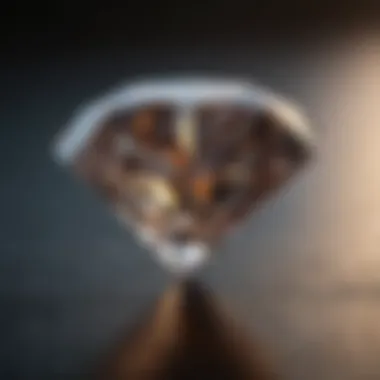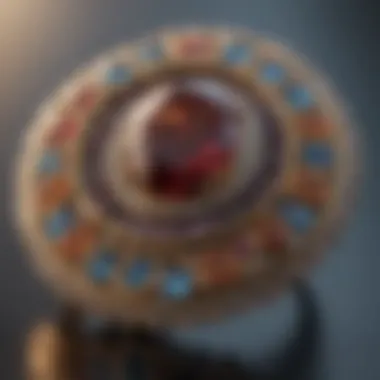Loose Diamonds and Gemstones: Their Charms and Intricacies


Intro
The realm of gemstones is as enchanting as it is complex. From the shimmer of loose diamonds to the vibrant hues of colored stones, the fascination begins far beyond their mere aesthetic appeal. The journey into understanding these natural marvels involves not only recognizing their beauty but also discerning the unique qualities, ethical considerations, and cultural significance tied to each gem. This comprehensive exploration aims to unwrap the multi-layered aspects of loose diamonds and gemstones, guiding enthusiasts and collectors alike through the labyrinth of choices available.
Gemstone Overview
Description of the Gemstone
Gemstones are precious or semi-precious minerals that have been cut and polished for ornamental purposes. Each gemstone tells a story – from its formation deep within the earth to its ultimate role in jewelry that may hold sentimental or financial value.
Loose diamonds, for instance, are unmounted stones often evaluated for their cut, carat weight, color, and clarity. Yet, their true charm lies in how they can be transformed into personalized pieces, resonating with their owner’s individuality. On the other hand, colored gemstones, such as sapphires, emeralds, and rubies, offer a spectrum of colors and are often associated with distinct meanings and historical significance.
Physical Properties
When it comes to physical properties, gemstones exhibit a range of characteristics that contribute to their allure:
- Hardness: This is measured by the Mohs scale. Diamonds, ranking the highest, boast exceptional hardness, making them ideal for everyday wear.
- Color: A gemstone's hue often dictates its value and desirability. The intensity and saturation of color can vary significantly between individual stones, making some exceptionally rare.
- Clarity: This aspect refers to the presence of inclusions or blemishes, with stones of higher clarity generally fetching higher prices.
- Cut: How a gemstone is cut affects its brilliance and how well it reflects light, ultimately influencing its visual appeal.
For anyone delving into gemology, understanding these physical properties is crucial as they affect everything from the stone's durability to its market value.
Healing Properties
Metaphysical Attributes
Throughout history, gemstones have been attributed with various metaphysical properties. For example, many believe that amethyst aids in achieving balance and clarity of mind, while citrine is associated with prosperity and success. This connection between gemstones and human experience enriches their significance beyond mere aesthetics.
Common Uses in Holistic Practices
In holistic practices, gemstones find roles in various therapies:
- Meditation: Many practitioners use stones like selenite or clear quartz to enhance their meditation experiences, believing these stones radiate positive energy.
- Crystal Healing: Each gemstone is thought to have specific vibrations that can aid in emotional, physical, or spiritual healing. For instance, rose quartz is often used to promote love and compassion.
- Aura Cleansing: Some gemstones are believed to cleanse one’s aura, acting as shields against negative energies.
"Gemstones are not just beautiful objects; they represent profound connections to history, culture, and the universe itself."
Through this overview, it becomes clear that gemstones hold a dual identity as both physical entities and symbolic treasures. Understanding both dimensions enriches the appreciation for these remarkable gifts from nature and informs the decisions made by gemstone enthusiasts, collectors, and casual buyers alike.
The World of Loose Diamonds
Loose diamonds form a captivating realm within the jewelry landscape. They aren't confined to settings; instead, they stand alone, allowing enthusiasts to appreciate their raw beauty and potential. When you think about a diamond, the first image that pops into your mind is likely the one set in a ring or necklace. However, loose diamonds offer a blank canvas for creativity. They provide flexibility to jewelry designers, collectors, and simply those who enjoy exploring the shimmering uniqueness of every stone.
Understanding loose diamonds is crucial for anyone considering a diamond purchase. These stones can be crafted into custom pieces, or they might serve as beautiful investment assets. Buying loose means you have the chance to choose the perfect stone that fits your style and preferences.
In this section, we delve deeper into what defines loose diamonds and explore the Four Cs—Cut, Color, Clarity, and Carat Weight—that play significant roles in the beauty and value of these exquisite gems.
Defining Loose Diamonds
Loose diamonds are diamonds that are sold as individual stones, separate from any jewelry setting. This sleek style presents buyers with ample choices as they can select not only the diamond itself but also tailor how it will be displayed in the future, whether it be in a ring or a pendant. Loose diamonds allow for a deeper appreciation of the stone's essence—seeing it in its pure form without the influence of a setting. Simply put, loose diamonds are the essence of potential; they can transform into whatever your imagination desires.
The Four Cs of Diamonds
A conversation about diamonds would not be complete without discussing the Four Cs: Cut, Color, Clarity, and Carat Weight. These characteristics help define the overall quality and value of a diamond, guiding buyers in making informed decisions.
Cut: The Impact on Brilliance
The cut of a diamond is paramount. It dictates how light interacts with the stone, affecting its brilliance and aesthetic appeal. Diamonds can be cut in various styles, including brilliant, princess, and emerald cuts. The most well-known is perhaps the round brilliant cut, which maximizes light reflection and produces the scintillation many desire.
A well-cut diamond not only maximizes sparkle but also influences overall appearance. If the cut is poor, even a high carat stone won't shine brightly, and may even come out looking dull. Thus, for anyone serious about gemology or jewelry design, cut is definitely a vital consideration.
"A diamond's cut is like the shoulder pad of a suit; it holds everything together and makes it shine."
Color: Understanding Variations
When we refer to the color of diamonds, we're usually discussing the rare, colorless variety to rare shades, including yellows, browns, and even stunning blues. The diamond color grading scale ranges from D (colorless) to Z (light yellow or brown). A colorless diamond offers the highest level of brilliance, as each facet reflects light without any color interruption.
However, colored diamonds such as canary yellow or blue have their own allure. Their unique hues can captivate buyers with a discerning eye. The preferences for diamond color differ vastly; a collector may seek out vivid-colored stones, while a couple may wish for a classic colorless diamond, showcasing the distinction in personal taste.
Clarity: Grading the Flaws
Clarity refers to the absence of inclusions and blemishes in a diamond. The GIA clarity scale ranges from Flawless to Included. While some inclusions can be invisible to the naked eye, their presence can influence a diamond's value significantly. Buyers often prefer diamonds with higher clarity grades to maximize their investment and ensure brilliance.
Understanding clarity is more than just examining the stone. It involves knowledge of how these traits affect overall visual appeal and value. For example, a diamond that is graded as VVS, or Very Very Slightly Included, might be almost indistinguishable from a Flawless diamond, yet can be significantly cheaper. Hence, knowing these nuances can lead to wiser purchases.
Carat Weight: The Pricing Factor
Carat weight is often misunderstood as the only measure of a diamond's value. While it does play a role, it's crucial to understand that two diamonds of the same carat weight can vary widely in price based on cut, color, and clarity. Carat weight is simply the measurement of the physical size of the diamond; more weight traditionally equates to higher value, but the other Cs take precedence.
A well-rounded buyer will not just look for large carat weights; they will seek the balance of the Four Cs to find the diamond that sparks the most joy for them at a spirited price. Therefore, focusing solely on carat weight without considering the overall quality can lead to regret in the long run.
Understanding Gemstones
When diving into the realm of loose diamonds and gemstones, grasping the intricacies of gemstones is vital. Each gemstone carries its own stories, traditions, and significance that enrich the understanding of these natural wonders. By learning about gemstones, enthusiasts can make informed choices that resonate not just in terms of aesthetics but also in investments, sustainability, and personal meaning.
The Nature of Gemstones


Gemstones are the earth's jewels crafted over millions of years, and their allure speaks to many facets of human interest—from their geological origins to cultural symbolism. Understanding the nature of gemstones brings clarity to their value and charm.
Types of Gemstones: Precious vs. Semi-Precious
The distinction between precious and semi-precious stones isn't merely a marketing tactic; it's a categorization grounded in rarity and quality. Precious gemstones include diamonds, rubies, sapphires, and emeralds. Their scarcity and durability give them an undeniable prestige. Semi-precious stones, such as amethyst, citrine, and garnet, also offer remarkable beauty but are more abundant and accessible.
Some key characteristics of these classifications include:
- Rarity: Precious stones are often rarer than semi-precious ones, leading to higher prices.
- Durability: The hardness of a stone, rated on the Mohs scale, often determines its classification. Precious stones often boast a more resilient nature.
Why are these distinctions beneficial? For collectors or jewelry designers, understanding this classification is crucial for making choices that reflect both beauty and investment potential. However, it's essential to note that the market can fluctuate significantly based on trends and demand.
On the other hand, semi-precious stones hold unique value for their diverse colors and designs. They offer versatility, allowing for creative expression in jewelry without the hefty price tag of their precious counterparts.
Formation Processes: Geological Insights
The formation of gemstones is a tale of heat, pressure, and time. Each type has its unique geological journey, influencing its characteristics and value. For instance, diamonds form under extreme heat and pressure deep within the Earth's mantle, while amethysts grow in volcanic rock cavities.
Here are some fundamental insights related to gemstone formation:
- Geological Environment: The specific conditions under which a gemstone forms heavily influence its characteristics.
- Temporal Aspect: Many gemstones take millions of years to develop, which adds to their allure and perceived value.
Understanding the formation processes sheds light on how and why certain gemstones exist. This knowledge aids enthusiasts in appreciating the complex origins of their stones and considering their ecological impacts.
The Role of Color and Clarity in Gemstones
Color and clarity are two pivotal aspects in appraising the true beauty and value of gemstones. They can dictate everything from price to market demand.
Color Theory: The Science of Gemstone Color
Color is one of the most immediately noticeable characteristics in gemstones. It is defined by three primary attributes: hue, tone, and saturation. Hue refers to the basic color, while tone indicates lightness or darkness, and saturation reflects the intensity.
Key points regarding color theory include:
- Desirability: Some color variations are highly sought after; for example, a deep blue sapphire is often more valuable than a lighter shade.
- Market Influence: Certain colors can trend over time, impacting the gems’ desirability and pricing.
Understanding the science behind color can push a buyer’s savvy meters up a notch. But beware, the allure of color doesn’t always equal quality. Some gems may look stunning but lack durability, making color a multifaceted consideration.
Clarity Grades: Implications for Value
Clarifying what clarity means is essential for anyone serious about purchasing gemstones. Clarity ranks how clear or transparent a gemstone is, considering any imperfections or inclusions. High-quality gemstones typically have fewer visible inclusions, thus commanding significantly higher prices.
Consider these factors:
- Inclusions: Natural imperfections can introduce character and uniqueness, but they often reduce market value.
- Grades: Clarity is graded from Flawless to Included, giving buyers a benchmark for assessing gems.
Understanding clarity can directly affect an enthusiast's investment strategy and satisfaction. A keen eye for clarity might mean the difference between a treasure and a dud.
In summary, learning about gemstones goes beyond aesthetics. It enhances one's ability to appreciate the historical, emotional, and economic contexts surrounding these exquisite stones.
Buying Loose Diamonds and Gemstones
Diving into the realm of loose diamonds and gemstones involves much more than mere aesthetics; it’s a journey of informed choices. Buying these precious stones not only satisfies an eye for beauty but also serves a variety of purposes – from investment to personal expression. Understanding where and how to buy them can make a significant difference in both the purchasing experience and long-term satisfaction.
Where to Buy: Reputable Sources
Certified Dealers: Understanding Certifications
When it comes to buying loose diamonds or gemstones, certified dealers are the gold standard. These dealers often possess credentials from reputable grading institutions like the Gemological Institute of America (GIA) or the American Gem Society (AGS). Their certification assures buyers that the stones are accurately represented regarding quality and authenticity.
Buying from certified dealers means you’re not flying blind. The certifications provide an objective assessment of the stone based on the Four Cs and other relevant factors. This not only justifies the price but also enhances the overall trust in your purchase.
However, not every certified dealer is created equal. Some may charge a premium for their name without offering superior quality stones. Therefore, it’s crucial to do your homework—research the dealer's reputation and customer feedback. This groundwork can save a buyer from potential headaches down the line.
Online vs. Brick-and-Mortar: Pros and Cons
In the age of digital shopping, the choice between online and brick-and-mortar stores has become more significant. Each option comes with its own set of advantages and disadvantages.
For instance, online platforms provide a wider selection. You can browse countless vendors and compare prices from the comfort of your home. Nevertheless, the experience may lack the tactile feedback one gets when handling a stone in a physical store.
On the flip side, visiting a brick-and-mortar store allows for personal interaction. Buyers can see, touch, and examine gemstones under appropriate lighting, which is critical since appearance can change dramatically based on the environment. The downside? The limited variety and often higher prices due to overhead costs.
Evaluating Quality: Practical Tips
Examining Stones: Tools and Techniques
Knowing how to examine stones is crucial whether you're a first-time buyer or a seasoned collector. Specific tools like loupes and microscopes can greatly enhance your ability to identify flaws and overall quality. For instance, a loupe magnifies the stone, allowing you to inspect facets and clarity closely.
Moreover, understanding how to evaluate the brilliance and sparkle of a diamond demands practice. Techniques such as the “diamond test” using a thermal conductivity tester can help distinguish real diamonds from imitations. This careful examination can prevent costly mistakes, thereby ensuring that you're making a sound investment.
Negotiating Prices: An Art and a Science
Many buyers shy away from negotiating prices, thinking it’s a daunting task best left to experts. However, knowing the art and science behind it can boost your confidence immensely. Research is key here—having knowledge of current market prices can empower a buyer during negotiations.
When you’re aware of the stone's fair value, you can engage in conversations more assertively. Use phrases that show you've done your homework, such as, "I’ve noticed similar gems priced lower at other places. What can you offer me?" This not only expresses your knowledge but often encourages the dealer to provide a better deal.
There’s a delicate balance in negotiating; being too aggressive can turn off a seller, while being too passive may leave money on the table. Approach negotiations as a conversation rather than a battle.


"Knowledge is power when it comes to buying gems; being informed leads to better choices and greater satisfaction."
Cultural and Historical Significance
The story of loose diamonds and gemstones is intertwined with human history in ways both rich and meaningful. Understanding their cultural and historical significance allows us not only to appreciate their beauty but also to connect with the narratives they carry across time. Different cultures have imbued these stones with remarkable symbolism, linking them to luck, protection, and even power. Observing these historical contexts provides valuable insight into the motivations behind buying and wearing these precious pieces.
Gemstones in History
Ancient Cultures: Symbolism and Use
Gemstones have long held a revered place in ancient societies. For instance, the Egyptians prized lapis lazuli for its deep blue color, associating it with the heavens and spirituality. They adorned their tombs with these stones, expressing a belief that these gems would continue to protect and guide their souls in the afterlife.
This association between gemstones and spiritual significance is important. It demonstrates that these stones were viewed as more than mere adornments; they were believed to possess the power to influence the human experience. Finding such gems gives historians insights into ancient trade routes and cultural exchanges as they traveled through different civilizations, bringing with them their diverse meanings and uses.
The disadvantage, however, lies in the lost interpretations of how stones were valued in different cultures, raising questions about the extent of their uses—were they primarily decorative, or did they also hold pure functional traits? This aspect remains a topic of exploration, as modern-day enthusiasts seek to trace the relationship between ancient beliefs and contemporary value assessments.
Royalty and Gemstones: A Curated Relationship
Throughout history, gemstones have been the envy of royalty and nobility, acting as symbols of status and wealth. The most famous example is the British Crown Jewels, where every stone possesses a unique tale, such as the Koh-i-Noor diamond, which translates to "Mountain of Light"—a name borrowed from its captivating sparkle and storied past of conquest and intrigue.
In this way, the connection between royal lineage and gemstone acquisition has contributed significantly to the lore surrounding these stones. By showcasing such pieces, royals solidified their power and adorned themselves with talismans believed to bring good fortune and divine favor. These gems often served political purposes as well, such as when they were used as gifts to forge alliances.
However, the canny use of gemology in politics is a double-edged sword. While these gemstones can symbolize righteousness and prosperity, they also come with historical blemishes, as many treasured gems have dubious origins. For instance, some carry the stain of colonial exploitation. Therefore, understanding this curated relationship requires a critical eye, appreciating the beauty of the stones while recognizing the complex narratives that accompany them.
Modern Cultural Beliefs
Birthstones: Traditions and Myths
Moving to contemporary times, birthstones serve as a significant part of personal identity and cultural expression. Each month is ascribed a specific stone believed to provide special powers or benefits to those born during that time. For example, garnets for January are seen as symbols of protection and energy, whereas sapphires for September represent wisdom and royalty.
This connection of birthstones to personal narratives can bring enthusiasts closer to their stones, making them feel more meaningful than a mere token. The advantageous spin of wearing a birthstone is this intrinsic relationship it fosters; they become imbued with personal significance. However, modern commercialization of birthstones sometimes veers away from their authentic lore, raising questions about whether consumers are contributing to genuine traditions or merely participating in a marketing ploy.
Gemstones in Popular Culture
The role of gemstones in popular culture is omnipresent and versatile. From Taylor Swift’s lyrics to iconic films like "Titanic," where the Heart of the Ocean necklace captures the audience's imagination, gemstones often symbolize love, nostalgia, and even tragedy. This pervasive presence demonstrates how stones embody emotions and memories, making them ever more significant in our collective consciousness.
However, while reflected in the zeitgeist, there is an element of superficiality that accompanies their portrayal. The oft-romanticized view may overshadow the stones' real-world implications, such as ethical considerations in sourcing. An awareness of pop culture interpretations can be enlightening, yet it should be balanced with informed perspectives on sustainability and ethical practices in the gemstone industry.
Understanding the interplay between cultural significance and gemstones allows us to appreciate their value beyond aesthetics. They tell the stories of our past, embodying legacies that still resonate today.
Ethical Sourcing and Sustainability
Understanding the ethical sourcing of loose diamonds and gemstones is increasingly vital in today’s jewelry landscape. Consumers today demand transparency about where their gems come from and how they are sourced. This awareness is not just an act of compliance but a movement towards enabling responsible practices in the mining industry. Ethical sourcing not only protects the environment but also supports fair labor practices and brings to light issues like human rights abuses often linked with gemstone mining. In short, it's about making informed choices that benefit both the planet and its people.
The Importance of Ethical Practices
Conflict Diamonds: Understanding the Issue
Conflict diamonds, often referred to as "blood diamonds," have drawn considerable attention over the years due to their association with violence, human rights violations, and war. The whole notion behind conflict diamonds is that they finance armed conflict, especially in war-torn regions of Africa. The sales of such diamonds often help fund insurgent groups whose actions can lead to devastating consequences for local populations. It's important to recognize that buying conflict diamonds can inadvertently support these oppressive activities.
Here’s why the topic is crucial for this article:
- Consumer Awareness: Shoppers must know the origins of their gems. Awareness leads to informed choices that prioritize ethical considerations.
- Key Characteristics: Understanding how conflict diamonds are sourced offers insights into the broader implications of the gemstone market.
- Responsibility in Purchases: Making conscious choices can help create an ethical market. Buying diamonds that are sourced responsibly motivates miners and retailers to prioritize ethical practices.
While awareness about conflict diamonds has significantly increased, it’s essential to also incentivize businesses that follow ethical guidelines. The unique feature of addressing this issue not only pushes for better practices but also promotes a better reputation for the jewelry industry itself.
Responsible Mining and Fair Trade Practices
Responsible mining encompasses a variety of sustainable practices, focusing on the environmental and social impacts of gem extraction. When mines adhere to ethical guidelines, including labor rights and environmental stewardship, they lay the foundation for an industry that respects both people and the planet. Fair trade practices, in particular, help ensure that miners are paid fairly for their labor and that the extraction processes do not degrade the surrounding ecosystems.
- Key Characteristics: Responsible mining guarantees that both the environment and human rights are protected. Essentially, this style of mining reflects a collective effort to reduce the exploitation of vulnerable communities.
- Benefits for the Industry: Investing in responsible mining can lead to a more sustainable and thriving industry, where ethical practices enhance craftsmanship and visibility.
- Unique Features: The use of innovative technology can improve mining conditions and increase transparency in the sourcing process.
Fair trade practices also help create a dynamic market where buyers can feel confident in their purchases. As consumers turn towards these responsible alternatives, they contribute to a larger movement that values ethical standards in gemstone sourcing.
Sustainable Gemstone Choices
Sustainability in gemstone choices is gaining momentum as a preferred avenue for those looking to make a difference. Whether one chooses synthetic stones or recycled gems, each route offers its own set of advantages and considerations, shaping the future of jewelry.
Synthetic vs. Natural Stones: Pros and Cons
The debate between synthetic and natural stones often raises eyebrows. Synthetic gemstones mimic the chemical and physical properties of their natural counterparts but are created in laboratories. One of the key characteristics of synthetic stones is that they can be produced at a relatively lower cost and with less environmental impact.
Pros:
- Environmental Benefits: Lower ecological footprint compared to traditional mining.
- Cost-effective: Generally less expensive than natural gemstones, making fine jewelry more accessible.
Cons:
- Perceived Value: Some collectors and enthusiasts prioritize natural stones for their uniqueness, which can lead to a stigma against synthetics.
The unique angle here lies in the potential for synthetic gemstones to be widely accepted as viable alternatives, especially for consumers striving for environmental sustainability without sacrificing aesthetics.
Recycled Gemstones: A Growing Trend


Recycled gemstones represent an innovative solution to the pressing environmental issues linked to mining and gemstone production. By repurposing existing stones that have been previously crafted into jewelry or other forms, the market accesses a source that reduces the impact of new mining. This trend taps into both sustainability ideals and the growing demand for unique stories behind gems.
Key Characteristics:
- Circular Economy: Recycled gemstones support the idea of reducing waste and lengthening the lifecycle of existing materials.
- Unique Appeal: Each recycled stone carries a history, making them captivating for collectors and buyers alike.
Benefits of Recycled Gemstones:
- Reduced Environmental Impact: Less mining means lesser destruction of natural habitats.
- Cost Efficiency: Often cheaper than new stones, without compromising quality.
This trend signifies a shift towards a more sustainable future in the gemstone industry. By showing interest in recycled options, consumers take a stand for responsible choices, supporting an industry that prioritizes ecological balance and ethical practices.
Care and Maintenance of Loose Diamonds and Gemstones
Caring for loose diamonds and gemstones is not just a task—it’s a commitment to preserving their beauty and value. Whether you’re a collector or a passionate aficionado, understanding the nuances of their care can ensure that these treasures retain their luster for generations. Improper handling can lead to wear and tear, diminishing the stone’s sparkle and value considerably. Thus, it’s paramount to adopt suitable practices for both cleaning and storage to protect your investment.
Basic Care Techniques
Cleaning Methods: Best Practices for Longevity
Cleaning your gemstones regularly is essential to maintain their brilliance. It ensures that dirt and oil don’t dull their sheen over time. One of the most effective methods is to use a simple soap-and-water solution. Just mix a few drops of mild dish soap with warm water and soak the stones for a few minutes. Using a soft toothbrush gently removes stuck debris, paying special attention to the settings where dirt accumulates.
Key Characteristics:
This method is popular because it’s safe and avoids harsh chemicals that could potentially harm the stone. The softness of dishwashing soap is gentle enough not to damage gemstone coatings, ensuring longevity without risking scratches or blemishes.
Advantages/Disadvantages:
While this method is effective for many types of gemstones, some stones like opals or emeralds, which are more porous, may require specialized care to avoid lasting damage. Therefore, understanding the unique properties of your stone is crucial.
Storage Solutions: Protecting Your Investment
How you store your loose diamonds and gemstones is nearly as important as how you clean them. Ideally, they should be stored separately in soft pouches or lined boxes to avoid scratches from other stones. A dedicated jewelry box with compartments can be an excellent choice, keeping your treasures organized and protected.
Key Characteristics:
This method is beneficial because it minimizes the risk of unintentional damage that can occur when stones are jumbled together in a container.
Advantages/Disadvantages:
While investing in proper storage may seem unnecessary at first, the benefits far outweigh the cost. A small investment in quality storage can save you from costly repairs or a decrease in value down the line.
Professional Services
Appraisals: The Importance of Professional Insight
Regular appraisals are crucial in maintaining an accurate understanding of your gemstones' value. A professional appraiser can provide insights not just on the current market value but also the gemstones' quality, helping you make well-informed decisions whether you’re buying, selling, or insuring them.
Key Characteristics:
Professional appraisals offer a thorough assessment, detailing the quality factors like cut, clarity, carat weight, and color, which are essential for understanding true value.
Advantages/Disadvantages:
Though there is often a cost associated with obtaining a professional appraisal, the assurance of having an expert’s perspective can save you from undervaluing your pieces or making poor purchasing decisions.
Repairs: When Professional Help is Necessary
Sometimes, even the most careful owners find themselves in need of repairs. Whether it’s a loose stone, a damaged setting, or simply wear from time, knowing when to seek professional help can preserve the integrity of your gemstones.
Key Characteristics:
Professional repair services can ensure that any work done to the gemstone or its setting is of quality standard—something that a DIY fix may lack.
Advantages/Disadvantages:
While repairs can come at a price, they often restore the gemstone to its original beauty, which could be significantly more cost-effective than risking total loss. It's about making informed decisions that balance your passion for gemstones with practical financial considerations.
Remember that a well-cared-for gemstone not only sparkles more brilliantly but also holds its value and charm much better over time. Embrace these care techniques and professional services to fully appreciate your collection's intricate beauty.
Investment Potential of Loose Diamonds and Gemstones
Investing in loose diamonds and gemstones often conjures thoughts of luxury and opulence, yet the true potential lies beneath their shimmering surfaces. Many buyers discover that these natural wonders can serve not only as personal adornments but also as worthwhile investments. With the right knowledge, one can navigate the complexities of the gemstone market to uncover valuable opportunities. This section delves into how loose diamonds and gemstones can be lucrative through understanding market trends and collecting strategies, making the investment journey both fascinating and profitable.
Market Trends: What to Watch
In the ever-evolving gemstone market, precise insights into trends can make the difference between a well-timed investment and a costly misstep.
Price Fluctuations: Understanding the Market
The first aspect worthy of attention is the phenomenon of price fluctuations in the diamond and gemstone market. Prices may ebb and flow based on factors such as supply, demand, and global economic conditions. Understanding these currents necessitates a keen eye on market trends.
From 2021 to 2023, several diamonds exhibited notable value increase, particularly colored diamonds like blue and pink, which have gained remarkable attention in the marketplace. Collectors are often drawn to these due to their scarcity and increasing demand.
However, it’s crucial to understand that price fluctuations can also play tricks on the unwary investor. The market isn’t always predictable, and even sought-after gems can experience sudden drops in value. Thus, it’s beneficial to stay updated through reputable resources and market analyses, as it allows investors to mitigate risks related to purchasing at inopportune moments.
Emerging Gemstone Markets: Opportunities and Risks
Emerging gemstone markets present both fresh opportunities and potential pitfalls for investors. Countries like Mozambique and Nigeria have captured the interest of buyers due to their untapped mines of remarkable gemstones, such as rubies and sapphires. Investing early in these markets can position investors favorably as these stones gain recognition for their quality.
However, aspiring investors should exercise caution. New markets can be volatile, impacted not only by mining practices but also the political climates in these regions. It’s imperative to conduct thorough research and keep a cautious approach to investing in gemstones from emerging markets, thereby weighing potential high returns against the inherent risks of instability.
Collecting as an Investment
Collecting loose diamonds and gemstones is not merely a hobby; it’s an art form intertwined with strategic planning.
Building a Collection: Strategic Approaches
When developing a collection, strategic approaches become crucial. It’s not just about collecting beautiful stones but about selecting pieces that potentially appreciate in value over time. One effective tactic is to focus on rare and high-quality gemstones that are likely to sustain or increase their worth. For example, consider the market pull of certain rare gemstones, such as Alexandrite and Paraiba Tourmaline.
Moreover, documenting your collection meticulously, from the origin of each stone to the details of their purchases, can enhance their story and possibly their value. Crafting connections with reputable dealers can also prove beneficial as they can provide invaluable insights on market shifts.
Insurance and Valuation Considerations
Last but not least, insurance and valuation considerations are of utmost importance. Every successful investor must ensure their collection is protected against unforeseen circumstances, such as theft or damage. Proper insurance coverage is a must, not just for peace of mind but also to help preserve the value of the investment.
Regular valuation of the collection is important, too. Market fluctuations mean that what was once seen as priceless might need reevaluation over time. Engaging with professional appraisers who grasp current market trends and specific characteristics of gemstones is essential for ensuring that one’s investment remains prudent and profitable.







